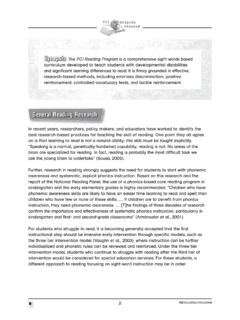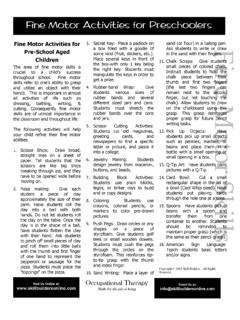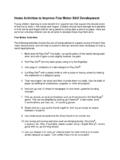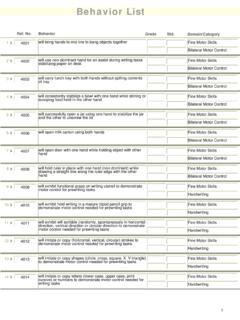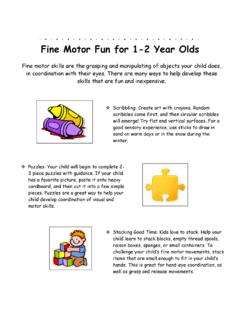Transcription of Peabody Developmental Motor Scales - PRO-ED
1 Peabody Developmental Motor ScalesSecond Edition(PDMS-2)Summary ReportSection I. Identifying InformationName: Tim ThomasExaminer: Cyndy ZochDate of Testing: 11-16-2012 Examiner Title: STDate of Birth: 11-17-2010 Clinic Name: OT ClinicPrematurity Adjustment: 44 daysClinic Location: Austin, TXAge: 22 monthsTest Location: PRO-EDSection II. Description of the PDMS-2 The Peabody Developmental Motor Scales - Second Edition (PDMS-2) is composed of six subtests that measureinterrelated abilities in early Motor development. It was designed to assess gross and fine Motor skills in children frombirth through five years of (Re) - This subtest measures aspects of a child's ability to automatically react to environmental events.
2 Because reflexes typically become integrated by the time a child is 12 months old, this subtest is given only to childrenages 2 weeks through 11 (St) - This subtest measures a child's ability to sustain control of the body within its center of gravity andretain (Lo) - This subtest measures behaviors that children use to transport themselves from one place to another,such as crawling, walking, running, hopping, and jumping Manipulation (Ob) - This subtest measures a child's movements needed to catch and throw objects. Becausethese skills do not become apparent until a child reaches 11 months of age, this subtest is only given to children ages 12months and (Gr) - This subtest measures a child's ability to use his or her hands.
3 It begins with the ability to hold an objectwith one hand and progresses up to actions involving the controlled use of the fingers of both hands to button andunbutton Integration (Vi) - This subtest measures a child's ability to use his or her visual perceptual skills to performcomplex eye-hand coordination tasks such as reaching and grasping for an object, building with blocks, and of the PDMS-2 subtests contribute to a Total Motor Quotient (TMQ). This score can most appropriately be thought ofas the best estimate of overall Motor abilities. In addition, each subtest contributes to either the Gross Motor Quotient(GMQ) or the fine Motor Quotient (FMQ) Motor Quotient (GMQ) - This quotient measures the ability to utilize the large muscle systems to move from placeto place, assume a stable posture when not moving, react automatically to environmental changes, and catch/throwobjects.
4 High scores on this composite are made by children with well-developed gross Motor abilities. These childrenwould have above average movement and balance skills. They are likely to be children who could be described as agile,well-coordinated, and graceful in their movements. Low scores are made by children who have weak movement andbalance skills. These children may have difficulty in learning to crawl, walk, and run. A deficit in gross Motor abilities canbe mild and the child's movements may be described as clumsy and uncoordinated. More severe gross Motor problemsmay limit a child's use of their legs to such a degree that they will need assistance to move from place to Motor Quotient (FMQ) - This quotient measures a child's ability to use his or her hands and arms to grasp objects,stack blocks, draw figures, and manipulate objects.
5 High scores on this composite are made by children with1well-developed fine Motor abilities. These children would have above average skills picking up small objects, drawingfigures, and stringing beads. They are likely to be described as good with their hands. Low scores are made by childrenwho have weak grasping and visual- Motor skills. They have difficulty in learning to pick up objects, draw designs, andusing hand tools. A fine Motor deficit can be mild; the child's skills may be described as immature. Some children mayhave problems severe enough to need specially designed utensils to feed PDMS-2 was normed on 2,003 children residing in 46 states and one Canadian province.
6 In general, thecharacteristics of the normative sample match information provided by the Bureau of the Census in 1997 forchildren under 5 years old with regard to geographic region, gender, race, rural or urban residence, ethnicity, familyincome, parent education, and of the test was examined in studies of internal consistency, stability reliability, and interscorer differences. Theinternal consistency reliability coefficients for the PDMS-2 subtests exceed .90 in most instances (range from .89 to .96).Internal consistency reliability coefficients for all PDMS-2 quotients exceed .90. Test-retest reliability coefficients werealso found to be greater than.
7 90 for most PDMS-2 scores, and coefficients depicting interscorer differences met orexceeded .96 for all subtests and validation of the PDMS-2 was demonstrated by showing that the abilities measured by the PDMS-2 subtest areconsistent with current knowledge regarding Motor skill development. In addition, indices of item discrimination anddifficulty are reported in the test manual. Finally, differential item functioning analysis procedures were used to provideevidence that the PDMS-2 is unbiased with respect to race, ethnicity, and validation of the test was examined by reporting significant correlations between the PDMS-2, thePeabody Developmental Motor Scales , and the Mullen Scales of Early Learning: AGS Edition.
8 Construct validation wasexamined by showing that performance on the PDMS-2 reflects developing abilities and that the PDMS-2 differentiatesbetween individuals known to be average and those expected to be low average or below average in Motor , the subtest scores intercorrelate as expected, and the exploratory and confirmatory factor analyses providevalidity for the PDMS-2 III. Record of PDMS-2 Subtest Scores RawAge (Re)N/AN/AN/AN/AN/AStationary (St)341096 Below AverageLocomotion (Lo)9420258 AverageObject Manipulation (Ob)1218167 Below AverageGrasping (Gr)4014258 AverageVisual- Motor Int. (Vi)801896 Below AverageSection IV. Profile of PDMS-2 Subtest Scores Std.
9 **77*66**55443322113 Section V. Comparison of PDMS-2 Subtest Scores for Significant DifferencesThis section is used to identify intra-individual strengths and weaknesses across subtests. As each comparison is made,consider the abilities that are assessed by each subtest to determine content strengths and MeasuredReflexes (Re)Reaction to environmental eventsStationary (St)Center of gravity and equilibriumLocomotion (Lo)Transfer from one base of support to anotherObject Manipulation (Ob)Throwing, catching, and kicking of objectsGrasping (Gr)Ability to use handsVisual- Motor Integration (Vi)Visual perceptual vs. StNoSt vs. ObNoLo vs. ViYes/LoRe vs. LoNoSt vs.
10 GrNoOb vs. GrNoRe vs. GrNoSt vs. ViNoOb vs. ViNoRe vs. ViNoLo vs. ObNoGr vs. ViYes/GrSt vs. LoYes/LoLo vs. GrNoSig. = Significant difference between subtestsDS = Dominant subtest (the one with the higher score)NA = Not available4 Section VI. Record of PDMS-2 Quotient Scores Sums of%ileQuotient 95%DescriptiveQuotientStd. ScoresRank ScoreIntervalRatingGross Motor (GMQ)2110817587 Below AverageFine Motor (FMQ)1412827688 Below AverageTotal Motor (TMQ)358797385 PoorSection VII. Profile of PDMS-2 Quotient Scores Std. **8080*757570706565606055555050454540403 5355 Section VIII. Information About Quotient PerformanceGross Motor QuotientTim's Gross Motor Quotient (GMQ) of 81 represents Below Average performance.

